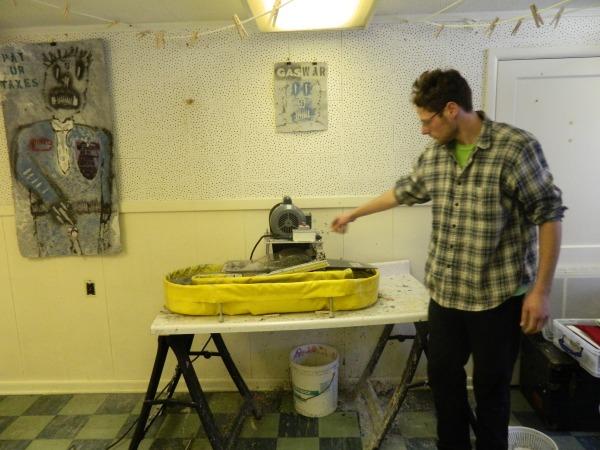
In 2008, Lewis, Mike Blake and Andrea Levine co-founded Veterans’ Sanctuary, and began running three initiatives: the Community Garden, Warrior Writers Veteran Group and Combat Paper Art Studio three years later in 2011.
The community-based program works to transition veterans from combat to civilian life by providing them the opportunity to process their military experiences through organic farming, writing and papermaking.What makes the Veterans’ Sanctuary unique is the Combat Paper Art Studio, where bits of denim, cotton, money, American flags and uniforms are cooked down, beaten and formed into sheets of paper that are bound and given to veterans.
Here, Lewis created a journal from his own uniform.“I still have one of my fatigues from Vietnam,” said outreach coordinator and Vietnam veteran Jim Murphy. “I find it very difficult to render it down to paper –– it’s part of me. So it’s a real statement when a veteran comes in with their fatigues and is willing to part with them, and make it into something more artistic and meaningful as the art or poetry you see here in the books.”
A partner project of Cornell University’s Center for Transformative Action, the sanctuary runs on a relatively low budget compared to other veteran outreach programs.“We’re all volunteers,” Lewis said. “We don’t need to raise money. Wounded Warriors and some of the other veteran organizations that do similar stuff pour in millions of dollars…we’re happy when we get some friends to come help us paint the walls.”
The Community Garden, a plot of land in Trumansburg donated by Gary Redmond – the late founder of the organic farm Regional Access – has between two to four veterans a week tending it, and produces medicinal and culinary herbs, fruit trees, even goji berries and horseradish, Lewis said.
On Wednesday February 13, Lewis, Murphy and another veteran sat flanked at the end of a table free writing poems about war and intimacy during one of the bi-weekly workshop nights in the Owl Cafe above the Autumn Leaves Used Books store on the Commons.
“It’s not a medical model,” Murphy said. “It’s not sitting in a sterile room in a circle with a trained counselor eliciting responses…it’s done in a sense of communication peer to peer.”
Lewis said their opposition to the war rouses dialogue on current events and past experiences; writing provides a sort of catharsis, turning “swords to plowshares.”
The sanctuary has been able to maintain operations through donations and volunteerism; however, daily participation can range anywhere from double-digits to just a single coordinator depending on the program, which Lewis attributes to respective personal and economic reasons.“I think a lot of veterans are worried about taking care of their families, food and shelter,” he said.The national average unemployment rate for Afghanistan and Iraq War veterans was 9.9 percent in 2012 (though improved from 12.1 percent in 2011) and remains high compared to the 7.8 percent national rate.“(Veterans) are a priority group that will receive any sort of counseling or basic services and more extensive services – a priority versus other individuals,” said Christian Harris, an economist at the New York Department of Labor.
Though Lewis is unsure what the future holds for the Combat Paper Art Studio and the Veterans’ Sanctuary as a whole, he is optimistic for potential future growth.
“I just hope we’re stronger and there’s more people, more veterans, real nice facilities,” he said. “Sometimes it’s hard to think around the bend, but ideally we’ll have a bigger program –– still making books, still making art.”